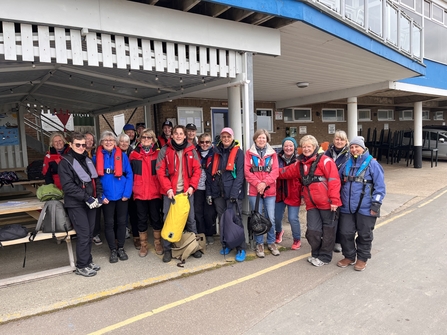To complete this journey, my aim was to enlist the help of local sailing clubs along the coastline. It was a logistical challenge, totalling nine days of travel in a variety of vessels, and I was frequently overwhelmed by the endless generosity of the Essex folk who live by the sea.
A voyage along the Essex coast

On day one I travelled with Thurrock Yacht Club to Leigh-on-Sea at 6.30am, passing Essex Wildlife Trust’s iconic Thameside visitor centre and the looming cranes of London Gateway as the wind whistled and the chop grew more ferocious. The saltings of Two Tree Island gave way to the blanket green of the Hadleigh Downs. Neighbouring Leigh-on-Sea was in view, with St George’s Cross fluttering atop St Clements Church.
The tide was ebbing fast, and our red RIB was churning up mud, so I jumped over the landward edge of the creek into thigh-high water and squelched my way to an algae-green, wooden slipway. When the guys were safely back at Thurrock Yacht Club, they sent a picture of me sinking into the Leigh silt and quipped, “I always knew you were a stick in the mud!”
The following morning, mist clung to each mast and the mournful wailing call of not-so-distant fog horns could be heard. My brother and I were due at Bell Wharf to board Endeavour, a Shannon-green cockle boat from Leigh. This living museum emerged from the mist, briefly moored and we boarded.
The sun strained through the mist making the sky a perfect white as Endeavour picked her way through the moorings. White cloud reflected perfectly off the flat calm water. Before long, we could make out the clubhouse of Thames Estuary Yacht Club and travelled towards it, keeping an eye on the depth gauge. Once we were close enough, Allan rowed my brother and I ashore in a green tender and we waved the Endeavour crew goodbye.
The further eastwards one travels, the wider the estuary grows until the safety net of the Kentish shore no longer sits on the right. I was acutely aware that from here on out, there would be nothing but open sea and the lowlands of Holland to catch me were I to be cast adrift. Everything would be more exposed, more unknown and further from home. How exciting.
My favourite day was day five, when I went on an Essex seal trip from Burnham-on-Crouch. I had booked a seal watching trip through Seal Trips Essex on a boat named Celtic Prince. We sailed along the River Roach and skipper, Andy, showed me the parts of Wallasea Island’s earth embankment which have been purposely collapsed by the RSPB to allow the sea to flood in, returning it to marshland and creating a haven for birdlife.
By Beagle Point, the site where Darwin’s ship was laid to rest, we spotted around 12 iron-stained female common seals, lying on the metallic mud in kidney bean shapes. One of the crew joked, “The seals that are not moving are concrete ones we placed there to make sure you get your money’s worth.” The trip took about two hours and was as informative as it was relaxing. This must be one of the best wildlife experiences in Essex, alongside Essex Wildlife Trust’s Nature Discovery Centres of course.
The following days took me from Burnham to Bradwell, Brightlingsea to Clacton and from there to Harwich – staying in various hotels and travelling in various vessels. Finally, I took a RIB to Manningtree surrounded by racing dinghies and my trip was complete. I had made it from the southern border to the northern border of Essex, by any means.
This trip revealed to me the wonders of out coastline, and how important it is to protect it by supporting Essex Wildlife Trust – especially during Marine Week!
Andrew Millham
Essex Wildlife Trust Ambassador

